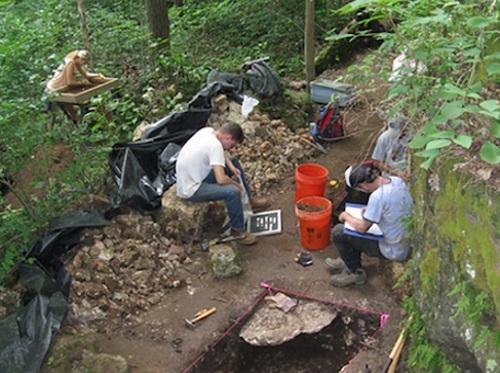The Kentucky Transportation Cabinet recently helped establish a new website highlighting more than 100 prehistoric and historic archaeological sites across the state’s 64 counties.
[Above photo by the Kentucky Heritage Council]
KYTC launched the new website – Discover Kentucky Archaeology – in collaboration with the Kentucky Heritage Council-State Historic Preservation Office, a Kentucky Tourism, Arts, and Heritage Cabinet agency. The website documents the “diversity and richness” of Kentucky’s archaeological record and the scientific documentation and research undertaken by more than 100 archaeologists who have and continue to contribute a “shared understanding” of the past.
Examples of “prehistoric” times covered by the website begin with Paleoindian-era sites (prior to 8000 B.C.) and range from Grizzly Newt – an Early Archaic (8000 to 6000 B.C.) Native American rock shelter located within the Daniel Boone National Forest – to McGilligan Creek, a Late Woodland (A.D. 500 to 1000) village in Livingston County.
Meanwhile “historic” time period examples include Saltpeter Cave, a Frontier era (A.D. 1750 to 1820) niter mine in Carter County, through sites like Peanickle; a Postbellum and Industrialization (A.D. 1865 to 1914) African American community on a ridgetop just outside Lawrenceburg.
Every profile of an archaeological dig on the new website – created by the Kentucky Archaeological Survey – includes a summary, findings, a focus on “what’s cool,” and links to related materials. Other sections include opportunities for public education, outreach, and discovery. Additional features and content for the website – designed by Kentucky Interactive LLC – will come as research and funding allow, KYTC said.
The new website received its funding via an alternative mitigation agreement for bridge projects, financed by the federal government. Through a consultation process, outlined by federal statute and supported by the Federal Highway Administration, consulting parties agreed to create a publicly available guide to Kentucky archaeological sites.
“While we are dedicated to preserving significant archaeological resources, sometimes damage from construction projects to cultural resources can’t be avoided,” said Craig Potts, executive director of the Kentucky Heritage Council and state historic preservation officer, in a statement.
“In this instance, we worked with partner agencies and consulting parties to develop a way to offset these damages by investing in public outreach to increase understanding of the importance of these sites and what they have yet to tell us about Kentucky’s heritage,” he said.
“As we build a better Kentucky that meets the needs of the future, [we are] committed to protecting and preserving Kentucky’s past,” added KYTC Secretary Jim Gray. “This initiative makes historical information accessible and enjoyable to discover across multiple periods and parts of the state.”
State departments of transportation across the country are involved in a variety of archaeological support efforts.
For example, in August, archaeologists from the Maryland Department of Transportation began helping excavate two small Colonial-era cabins near the historic Elkridge Furnace in Howard County, MD, located on land originally purchased for a highway project.
This effort follows a previous dig conducted by Maryland DOT’s archeological team in 2021 that helped discover a historic home site once owned by the father of famed abolitionist Harriet Tubman, who helped slaves escape north via the Underground Railroad.
Meanwhile, in February, the Nevada Department of Transportation and contractor Mead & Hunt began collaborating on an effort to develop a “multiple property documentation form” or MPDF to help preserve Latino-related properties statewide, with a primary focus on the cities of Las Vegas and Reno.
In addition, in January, the Colorado Department of Transportation debuted a documentary called “Durango 550 – Path of the Ancestral Puebloans” to show how the agency worked with archaeologists and regional Native American tribes to document, study, and ultimately share the discoveries unearthed near Durango in southwest Colorado.
